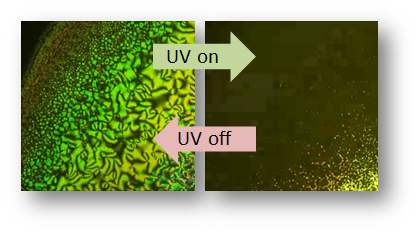Research

Modular approach to tailor-made liquid crystals for new functional materials
In the recent years, Supramolecular Chemistry has evolved into an effective approach to new functional materials. Combining building blocks by complementary binding sites leads to supramolecular aggregates with new properties e.g. liquid crystallinity. The advantage of a supramolecular approach is its versatility and dynamic, offering the materials to respond to changes of their environment. Our group is interested in utilizing the principles of Supramolecular Chemistry for the synthesis of novel liquid crystals. By developing a modular system of complementary core and peripheral units, our group aims to establish a tool box for the synthesis of liquid crystalline assemblies with tailor-made properties.

We are especially interested in the investigation of the molecular dynamics of these assemblies and their control by external stimuli such as UV-light. Differential scanning calorimetry (DSC), polarized optical microscopy (POM) and crystallographic analysis is used to investigate the liquid crystalline behavior and the molecular packing of the aggregates. The deeper insight in the molecular dynamics is achieved by solid state NMR.

Polarized optical micrograph proving the reversible switching between the mesophases by UV irradiation.
Self-Assembly on surfaces and in confined spaces
With respect to novel functional materials hybrids of organic and inorganic materials have gained considerable attention. For this reason our group aims to obtain a deeper understanding of the self-assembly and behavior of supramolecular aggregates on surfaces and in confined spaces of inorganic substrates such as silica.
Keywords: organic synthesis, self-assembly, liquid crystals, organic-inorganic hybrids

